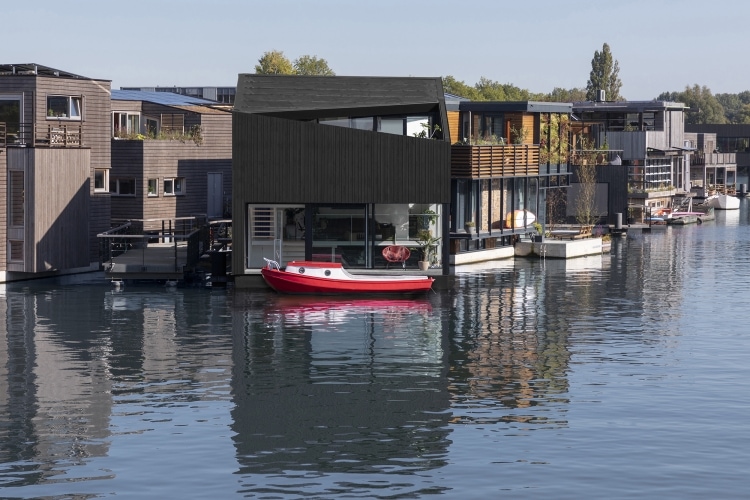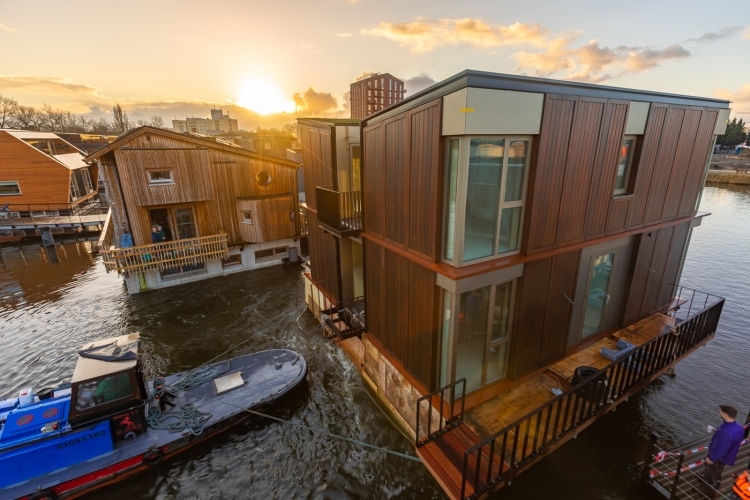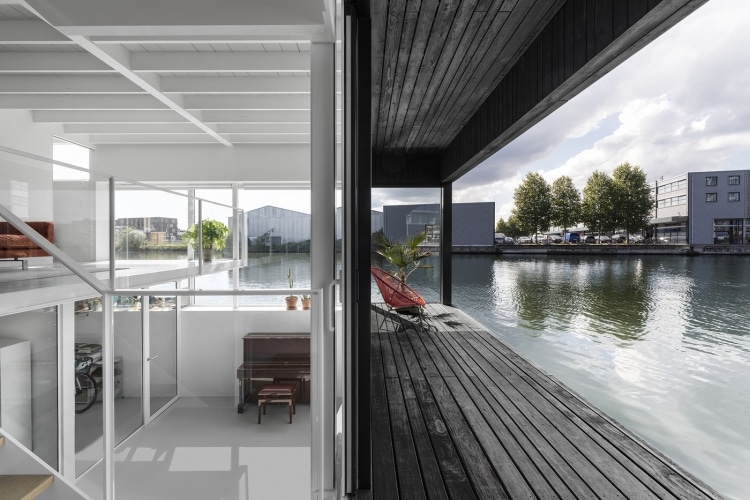Schoonschip: A New Wave of Sustainable Housing
A floating community has helped to revitalize a stagnant part of Amsterdam by injecting a new sense of waterborne style and eco-friendliness into the area.
Sustainability is THE buzzword of the new millennium. Its significance echoes through every aspect of development, from corporate governance to food and energy production, and the Sustainable Development Goals set down by the United Nations to create healthier and equitable societies that can stave off the catastrophic effects of climate change.
The term also applies to housing. In Holland, this pragmatic philosophy underlines the building of a new floating community called Schoonschip (‘Clean Ship’). The community, which accommodates 46 households and more than 100 residents, is located in a canal that branches off from the IJ River in Amsterdam North.

Within the smart grid of the village and the given boundaries of every water plot, every single home is able to be unique in architecture and interior design.
The project is the initiative of a so-called ‘CPO’ collective (a non-profit organization), the Dutch abbreviation for the commissioning of a project by a group of civilians, rather than by a commercial real estate developer. A group of passionate individuals with the shared dream of self-building a floating, sustainable community established the CPO and realized Schoonschip over the course of 10 years. To create a smart urban plan and secure the plot passports for all the dwellings, the group engaged Space&Matter.
The collective made a preferred list of materials and systems that could help to build sustainable homes. The community is almost energy self-sufficient. It employs circular building practices. Overall, it serves as a showcase for sustainable living.
As all residents chose their own architects, contractors and interior decorators, Schoonschip revels in personal touches and individuality. The result is an original urban living project much different from the typical gated community, where many of the different properties look like they were cloned from the same blueprints and materials. That’s why Schoonschip seems like a harbinger of the future, and an antidote to the burgeoning blandness of the world’s urban sprawl, chock-a-block with identikit condos and omnipotent franchises.

One of the homes designed by i29. The client’s brief was a home which would maximize the space within the volume boundaries of the plot yet still have a surprising house shape.
i29 architects constructed two of the floating homes. The firm adhered to sustainability specs developed by the CPO group, such as embedding solar panels on the roof. Speaking of the black monolithic home, i29 wrote in an email, “The floating home exterior design is the result of a space extensional study within the interior and vice versa. All areas are in open connection to the atrium, which comprises three floors, and the layout is extended with a split-level connection to a loggia terrace just above water level.”
In terms of structure the house is connected to the other 46 households by jetties, which includes a communal space for get-togethers in the post-Covid world. In this way, the overarching design allows for both a sense of privacy and a community vibe.
Sustainability is also informed by the three r’s that sum up what all of us can do to make the planet a little greener: reduce, reuse and recycle. In the case of Schoonschip, the project has been designed to repurpose and revitalize a once-tumbledown part of the city that’s making a comeback. Formerly an industrial shipyard, the northern part of Amsterdam is undergoing a creative renaissance, attracting the artistically inclined, and home to some of the city's edgiest architecture and hipster waterside hangouts. That development bodes well for those getting in the ground floor of this boom before it becomes too gentrified, especially now the recently opened Noord/Zuid metro line provides a fast link to central Amsterdam.
In a canal-laced city like Amsterdam, such a project also serves as a way of conserving space and preserving a waterborne way of life. Likewise, this floating community could be replicated in cities by the sea or bisected by waterways, such as Bangkok, Singapore, Pittsburgh or Barcelona. Surely in a space-starved city like Hong Kong, where real estate is at a premium, a project like this could work wonders to provide a more sustainable and less claustrophobic alternative to apartment living.
Space&Matter is ideally poised to lead such a revolution. From the beginning the firm has been fixated on coming up with what they call “an integral design approach for neighborhoods on water and on land.”
In an email Sascha Glasl of the company wrote, “Schoonschip was the first project of that scale and a perfect case study for us to develop a new standard for floating neighborhoods. During the last 11 years we have worked on several other floating projects with similar goals. We also developed a strong vision of the possibilities for living on water, which offers many possibilities for resilient city solutions. We are always interested in collaborating with other experts, citizens and municipalities to develop neighborhoods on water.”
But these kinds of developments also beg another, and much more troubling, question: Given the rising seas spawned by climate change, how sustainable are such communities? UN reports have claimed that the three cities to be most affected by those rising sea levels are Dhaka, Manila and Bangkok. Clearly, much more research has to be done before floating communities can be constructed without sacrificing long-term viability.
In the meantime, Schoonschip is a project that continues to grow and evolve. As one of the initiators of the CPO Group, Marjan de Blok, said in an email, “We are participating in all kinds of pilots, like sharing electric cars, which is something we would like to develop further. We have a smart grid that we are expanding. We give tours, share information, and help others who would like to realize a similar project. Also, the social sustainability is continuously in development.”
In the cutthroat world of real estate development, to see a group so open to sharing and collaborating with the public and other firms, is both inspiring and exemplary; it’s also a reminder that if we want a sustainable future for ourselves and our progeny we’re all in the same lifeboat and must learn how to row together.
INFO
Schoonschip
URL: https://schoonschipamsterdam.org
Facebook: www.facebook.com/Schoonschip
Instagram: @schoonschipAmsterdam
Space&Matter
URL: www.spaceandmatter.nl/schoonschip
Facebook: https://www.facebook.com/spaceandmatter
Instagram: @spaceandmatter
i29
URL: https://i29.nl
Facebook: www.facebook.com/i29-interior-architects
Instagram: @i29 architects

 日本語
日本語 English
English








